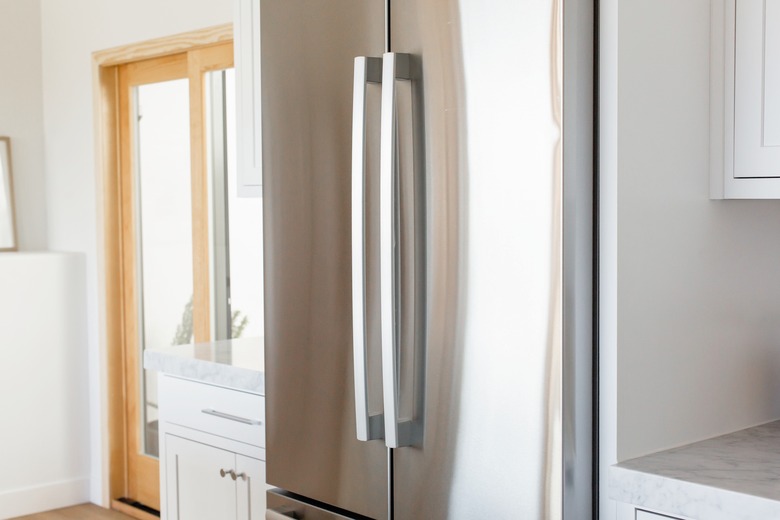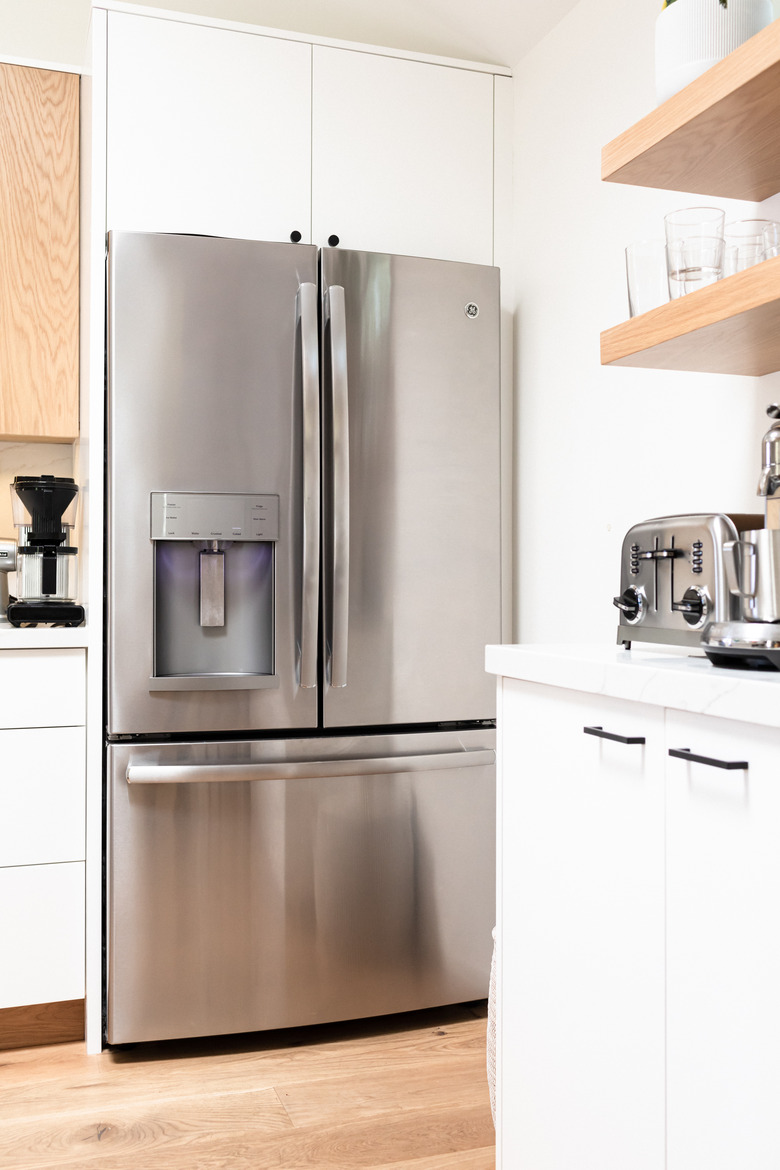How To Connect A Refrigerator Water Line For An Ice Maker
If you've bought a new refrigerator with a water dispenser and ice maker, you'll need to connect it to a water supply line. You may have no idea how to do this and find the thought of it overwhelming, but connecting a water line to your refrigerator ice maker is actually one of the simpler plumbing projects out there and one that most handy homeowners should be able to handle themselves.
The biggest problem with connecting the water line for an ice maker might be finding the most accessible cold water pipe. At least one hole will usually need to be drilled in either a cabinet wall or the floor behind the refrigerator to run the water line through. Other issues include choosing between the selection of water line materials and deciding how to tap into the water supply pipe. A little knowledge about the differences between these materials will help you decide which one is best for you.
Water Line Materials
Water Line Materials
The pipe size of most refrigerator water supply lines is 1/4 inch. In comparison, the water pipes feeding your faucets and other fixtures are 1/2 inch. The most common materials for a refrigerator ice maker supply line are copper, poly (plastic) and braided stainless steel. Each material has both benefits and drawbacks. Copper is strong and rigid and not prone to leaks, and though it is soft, it is less flexible than other materials. This lack of flexibility can lead to kinks and leaks, especially if the refrigerator is moved.
Poly is very flexible, making it easy to install in even the tightest situations. Because of this flexibility, it is easier to work with, often lessening both the labor and time needed to install the refrigerator water line. Its flexibility also makes it easier to move the refrigerator in and out. A drawback with plastic is that it is not as strong as copper and may become cut or kinked in some situations. Some homeowners also complain of a strange taste from the plastic.
The third option for a refrigerator water supply line, braided stainless steel, is the material that many plumbers consider the best because it is strong, durable and very flexible. Braided tubing is unlikely to cut or kink. This is the same material that plumbers use for sink and toilet supplies, although the ice maker water line is smaller and far more flexible. Braided tubing cannot be cut to fit like poly or copper, but it does have the needed fittings attached on both ends. Braided stainless steel can be a little costlier than poly or copper.
Tapping Into the Water Line
Tapping Into the Water Line
In order to get water to the refrigerator, you'll need to tap into a cold water pipe and run a line to the ice maker. There are a few ways to connect to the water pipe. The most common way to connect — and the way plumbers did it for years — is to use a saddle valve that clamps onto the water pipe. The benefits to using a saddle valve is that it can be installed quite easily and requires very few tools. The drawbacks are that saddle valves tend to leak as time goes by, and they can be difficult to turn off completely, especially if you have an older valve.
Because homeowners got tired of having saddle valve leaks and plumbers got tired of fixing them, many state codes do not allow saddle valves. An alternative way to hook up your ice maker line is to cut the cold water line and install a tee, a ball valve and a 1/4-inch compression fitting. You can do this with all types of water pipes, including copper and PEX.
The easiest way to do this is with SharkBite push-fit fittings, which can be used with copper, CPVC and PEX pipe. According to PlumbingSupply.com, SharkBite fittings have a tube support liner that allows the O-rings inside the fitting to fit and seal correctly on PEX tubing. The tube support liner is not required and can be easily removed if you plan to use SharkBite fittings with copper and CPVC pipe.
Things Needed
- 1/2 SharkBite x 1/2 SharkBite x 1/4-inch compression tee with valve
- 1/4-inch ice maker tubing
- Nut
- Compression ring
- Ferrule (optional)
- Drill and 5/16-inch drill bit
- Tubing cutter for PEX or copper pipe
- Adjustable wrench
-
1/2 SharkBite x 1/2 SharkBite x 1/4-inch compression tee with valve
-
1/4-inch ice maker tubing
-
Nut
-
Compression ring
-
Ferrule (optional)
-
Drill and 5/16-inch drill bit
-
Tubing cutter for PEX or copper pipe
-
Adjustable wrench
Connecting a Refrigerator Water Line
1. Find a Nearby Cold Water Pipe
Before you begin shutting off water valves, you'll need to find the closest cold water pipe to the refrigerator and plan the easiest route to take from the pipe to the refrigerator. After you plan the clearest route, you can drill a hole for your tubing.
- Locate the closest cold water pipe to the refrigerator. In many instances, the pipe will be located under the kitchen sink, but if the refrigerator is located far from the sink, the best option may be a cold water pipe in the basement.
- Determine if the route to the refrigerator is clear of drawers and other obstacles.
- Drill a hole through the cabinet (or the floor if connecting to a pipe in the basement). You may need to drill more than one hole if you are going through multiple cabinets. The ice maker tubing is 1/4 inch in diameter, so drilling a 5/8-inch hole will allow the tubing to pass through without kinking or cutting.
- If you use braided stainless steel tubing, the hole may need to be slightly larger because the fittings are already attached on both ends.
2. Install a Tee
The first and most important step in installing a tee is to shut off the water to the cold water pipe you are cutting. Some water will remain in the pipe, so have a container ready to catch it when you cut the pipe. You'll also want to open the cold water faucet to break the vacuum and allow it to drain better.
- After turning off the water, use your pipe cutter to cut the pipe. Allow the water inside the pipe to drain into a container.
- Mark the pipe with a pencil to the proper depth for your tee and cut the pipe a second time. PEX pipe is flexible enough that you may not need to make a second cut.
- Mark both pieces of pipe with the proper insertion depth for the SharkBite tee. Push the tee onto one of the pipes up to your mark and then insert the other pipe into the other end of the tee.
3. Connect the Water Line
The 1/4-inch tubing will need to be connected to both the 1/4-inch compression tubing on the tee and the back of the refrigerator.
- Run the water line tubing from the back of the refrigerator through the hole you've drilled and to the SharkBite tee.
- Install a nut and compression ring on the end of the tubing and connect to the tee, tightening the nut with a wrench. If you are using poly tubing, make sure to insert a ferrule in each end. With braided tubing, the nut and ring are already attached to the ends.
- Connect the other end of the tubing to the fitting located on the back of the refrigerator in the same way using a nut and compression sleeve. Don't cut the tubing to fit. Having extra behind the refrigerator will help prevent kinking when you pull the refrigerator out.
- Turn off the shutoff on your tee and then turn the water to your cold water pipe back on and check for leaks. Then, turn on the valve feeding your refrigerator water line.

